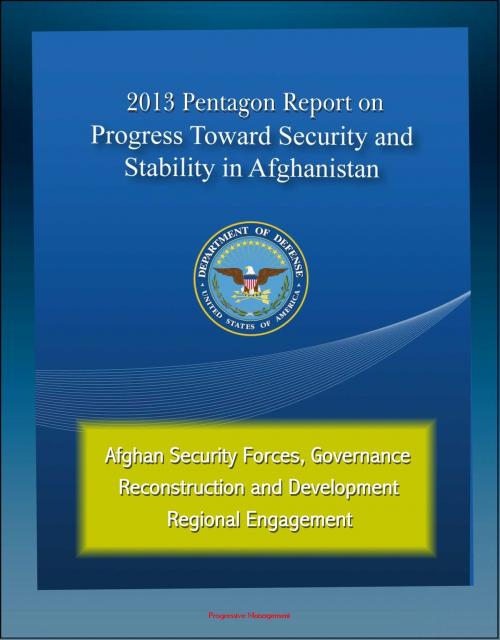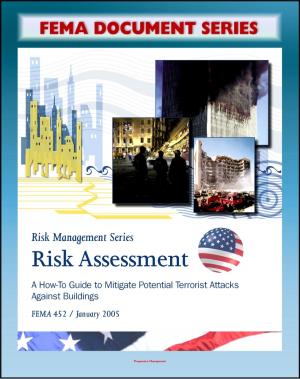2013 Pentagon Report on Progress Toward Security and Stability in Afghanistan: Afghan Security Forces, Governance, Reconstruction and Development, Regional Engagement
Nonfiction, History, Military| Author: | Progressive Management | ISBN: | 9781301272884 |
| Publisher: | Progressive Management | Publication: | August 2, 2013 |
| Imprint: | Smashwords Edition | Language: | English |
| Author: | Progressive Management |
| ISBN: | 9781301272884 |
| Publisher: | Progressive Management |
| Publication: | August 2, 2013 |
| Imprint: | Smashwords Edition |
| Language: | English |
The conflict in Afghanistan has shifted into a fundamentally new phase. For the past 11 years, the united States and our coalition partners have led the fight against the Taliban, but now Afghan forces are conducting almost all combat operations. The progress made by the International Security Assistance Force (ISAF)-led surge over the past three years has put the Government of the Islamic Republic of Afghanistan (GIRoA) firmly in control of all of Afghanistan's major cities and 34 provincial capitals and driven the insurgency into the countryside. ISAF's primary focus has largely transitioned from directly fighting the insurgency to training, advising and assisting the Afghan National Security Forces (ANSF) in their efforts to hold and build upon these gains, enabling a U.S. force reduction of roughly 34,000 personnel— half the current force in Afghanistan—by February 2014.
As agreed by President Obama and President Karzai at their January 2013 meeting in Washington, D.C., and in line with commitments made at the Lisbon and Chicago NATO summits, "Milestone 2013" was announced on June 18, 2013, marking ISAF's official transition to its new role. The ANSF has grown to approximately 96 percent of its authorized end-strength of 352,000 personnel and is conducting almost all operations independently. As a result, ISAF casualties are lower than they have been since 2008. The majority of ISAF bases has been transferred to the ANSF or closed (although most large ISAF bases remain), and construction of most ANSF bases is complete. Afghanistan's populated areas are increasingly secure; the ANSF has successfully maintained security gains in areas that have transitioned to Afghan lead responsibility. To contend with the continuing Taliban threat, particularly in rural areas, the ANSF will require training and key combat support from ISAF, including in extremis close air support, through the end of 2014.
SECTION 1 - SECURITY * SECTION 2 - AFGHAN SECURITY FORCES GROWTH, DEVELOPMENT AND OPERATIONS * SECTION 3 - GOVERNANCE * SECTION 4- RECONSTRUCTION AND DEVELOPMENT * SECTION 5 - REGIONAL ENGAGEMENT
SECTION 1 - SECURITY * 1.1: U.S. MISSION * 1.2: ISAF CAMPAIGN STRATEGY AND OBJECTIVES * Afghan Operational Plans * Security Force Assistance * Base Realignment and Retrograde Operations * 1.3: ISAF COMMAND AND CONTROL * 1.4: NATO-ISAF FORCE LEVELS AND PLEDGES * U.S. Force Levels * Bilateral Security Agreement * International Force Levels and Pledges * Caveats * 1.5: SECURITY OVERVIEW * A Note on Metrics * The Insurgency * ANSF-ISAF Operations By RC * 1.6: TRANSITION * Current State of Transition * 1.7: CIVILIAN CASUALTIES * 1.8: INSIDER THREAT * 1.9: REINTEGRATION * 1.10: PUBLIC PERCEPTIONS OF THE ANSF * 1.11: LOOKING AHEAD: THE NEXT 6 MONTHS * 1.12: ELECTION PREPARATION * SECTION 2 - AFGHAN SECURITY FORCES GROWTH, DEVELOPMENT AND OPERATIONS * 2.1: SUMMARY * 2.2: SECURITY FORCE ASSISTANCE * 2.3: INSTITUTIONAL CAPACITY BUILDING AND ASSESSMENT * Assessment of the Ministry of Defense * Assessment of the Ministry of Interior * 2.4: INSTITUTIONAL TRAINER AND MENTOR STATUS * 2.5: ANSF LITERACY TRAINING * 2.6: AFGHAN NATIONAL ARMY CAPACITY AND GROWTH * Manning * Force Development and Training * Special Operations Forces * Equipping and Enablers * Logistics Capability * Transition of Logistics * Afghan Air Force * 2.7: AFGHAN NATIONAL POLICE CAPACITY AND GROWTH * Manning * Force Development and Training * Equipping * Logistics Capabilities * Afghanistan National Civil Order Police * Afghan Border Police * Afghan Uniform Police * Police Special Forces * 2.8: AFGHAN PUBLIC PROTECTION FORCE * APPF Size and Composition * APPF Recruiting and Training * APPF Tasks and Missions * APPF Measures of Effectiveness improving APPF Performance * 2.9: LOCAL DEFENSE INITIATIVES
The conflict in Afghanistan has shifted into a fundamentally new phase. For the past 11 years, the united States and our coalition partners have led the fight against the Taliban, but now Afghan forces are conducting almost all combat operations. The progress made by the International Security Assistance Force (ISAF)-led surge over the past three years has put the Government of the Islamic Republic of Afghanistan (GIRoA) firmly in control of all of Afghanistan's major cities and 34 provincial capitals and driven the insurgency into the countryside. ISAF's primary focus has largely transitioned from directly fighting the insurgency to training, advising and assisting the Afghan National Security Forces (ANSF) in their efforts to hold and build upon these gains, enabling a U.S. force reduction of roughly 34,000 personnel— half the current force in Afghanistan—by February 2014.
As agreed by President Obama and President Karzai at their January 2013 meeting in Washington, D.C., and in line with commitments made at the Lisbon and Chicago NATO summits, "Milestone 2013" was announced on June 18, 2013, marking ISAF's official transition to its new role. The ANSF has grown to approximately 96 percent of its authorized end-strength of 352,000 personnel and is conducting almost all operations independently. As a result, ISAF casualties are lower than they have been since 2008. The majority of ISAF bases has been transferred to the ANSF or closed (although most large ISAF bases remain), and construction of most ANSF bases is complete. Afghanistan's populated areas are increasingly secure; the ANSF has successfully maintained security gains in areas that have transitioned to Afghan lead responsibility. To contend with the continuing Taliban threat, particularly in rural areas, the ANSF will require training and key combat support from ISAF, including in extremis close air support, through the end of 2014.
SECTION 1 - SECURITY * SECTION 2 - AFGHAN SECURITY FORCES GROWTH, DEVELOPMENT AND OPERATIONS * SECTION 3 - GOVERNANCE * SECTION 4- RECONSTRUCTION AND DEVELOPMENT * SECTION 5 - REGIONAL ENGAGEMENT
SECTION 1 - SECURITY * 1.1: U.S. MISSION * 1.2: ISAF CAMPAIGN STRATEGY AND OBJECTIVES * Afghan Operational Plans * Security Force Assistance * Base Realignment and Retrograde Operations * 1.3: ISAF COMMAND AND CONTROL * 1.4: NATO-ISAF FORCE LEVELS AND PLEDGES * U.S. Force Levels * Bilateral Security Agreement * International Force Levels and Pledges * Caveats * 1.5: SECURITY OVERVIEW * A Note on Metrics * The Insurgency * ANSF-ISAF Operations By RC * 1.6: TRANSITION * Current State of Transition * 1.7: CIVILIAN CASUALTIES * 1.8: INSIDER THREAT * 1.9: REINTEGRATION * 1.10: PUBLIC PERCEPTIONS OF THE ANSF * 1.11: LOOKING AHEAD: THE NEXT 6 MONTHS * 1.12: ELECTION PREPARATION * SECTION 2 - AFGHAN SECURITY FORCES GROWTH, DEVELOPMENT AND OPERATIONS * 2.1: SUMMARY * 2.2: SECURITY FORCE ASSISTANCE * 2.3: INSTITUTIONAL CAPACITY BUILDING AND ASSESSMENT * Assessment of the Ministry of Defense * Assessment of the Ministry of Interior * 2.4: INSTITUTIONAL TRAINER AND MENTOR STATUS * 2.5: ANSF LITERACY TRAINING * 2.6: AFGHAN NATIONAL ARMY CAPACITY AND GROWTH * Manning * Force Development and Training * Special Operations Forces * Equipping and Enablers * Logistics Capability * Transition of Logistics * Afghan Air Force * 2.7: AFGHAN NATIONAL POLICE CAPACITY AND GROWTH * Manning * Force Development and Training * Equipping * Logistics Capabilities * Afghanistan National Civil Order Police * Afghan Border Police * Afghan Uniform Police * Police Special Forces * 2.8: AFGHAN PUBLIC PROTECTION FORCE * APPF Size and Composition * APPF Recruiting and Training * APPF Tasks and Missions * APPF Measures of Effectiveness improving APPF Performance * 2.9: LOCAL DEFENSE INITIATIVES















